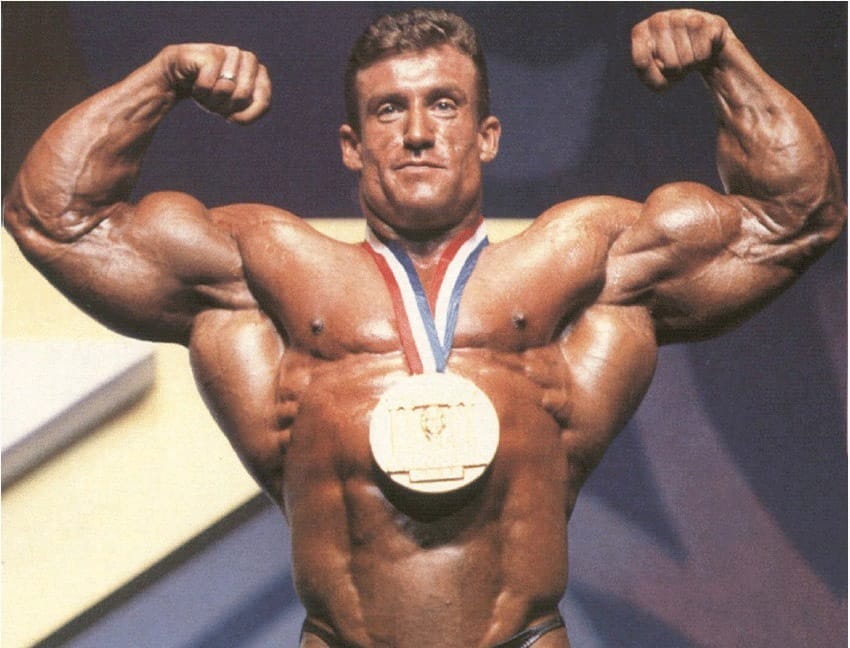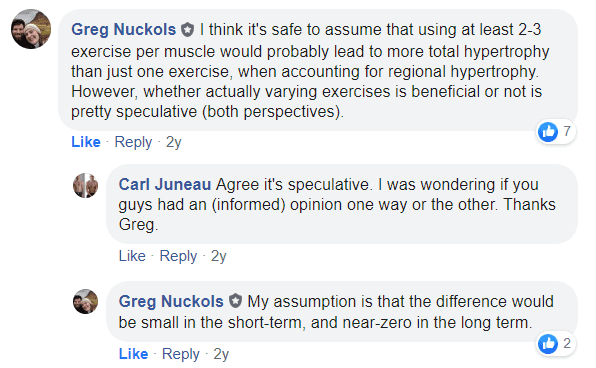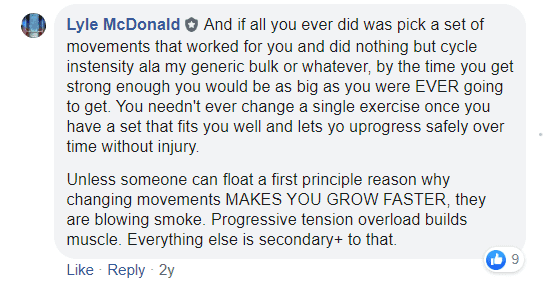'Huge Mistake': Changing Exercises Too Often for Muscle Growth
Bodybuilding champion Dorian Yates and other experts say it's a mistake to change your exercises often. What does the science say?

If you want to keep building muscle, you have to change your routine once in a while.
But how often should you change your exercises? Should you vary them a lot, or stick with a few?
After all, Olympic weightlifters and powerlifters build a lot of muscle performing mostly the same exercises over and over.
So has 6-time Mr. Olympia, Dorian Yates, who says it's a "huge mistake" to change your exercises every 4 to 6 weeks:
Good advice? Let’s see what the science and other experts say.
Science on changing exercises and muscle gain
In 2022, exercise scientists Kassiano et al. (2022) did a systematic review of the literature.
They examined whether varying resistance exercises leads to better muscle hypertrophy and strength gains compared to using fixed exercises. The research analyzed 8 studies with a combined sample of 241 young male participants.
Key Findings
They found that systematic variation can enhance:
- Regional muscle hypertrophy (growth)
- Dynamic strength gains
But they also noted potential drawbacks:
- Excessive or random variation may actually impair muscle gains
- Using different exercises that provide redundant stimuli could hinder progress
- High frequency of exercise changes may not be beneficial for muscular adaptations
They concluded that:
Some degree of systematic variation seems to enhance regional hypertrophic adaptations and maximize dynamic strength, whereas excessive, random variation may compromise muscular gains. -Kassiano et al. (2022)
Practical applications
This review finally provides evidence-based guidance, clarifying the ongoing debate about exercise variation in resistance training.
It suggests that exercise variation should be:
- Implemented systematically
- Based on anatomical and biomechanical principles
- Not overly frequent or random in nature
In short, while some variation is beneficial, it must be implemented strategically rather than randomly. Which is what we've been advocating for years here at Dr. Muscle. More on this later.
More studies on exercise variation and hypertrorphy
Let's look at two more studies that compared changing exercises often to sticking with the same routine.
- In a 12-week study (Fonseca et al. 2014), beginners saw their quadriceps cross-sectional area increase in similarly, regardless of exercise variation. However, groups with variation (3 leg exercises) saw all heads of their quadriceps hypertrophy, whereas groups without variation (1 leg exercise) did not. It’s unclear if differences were due to variation over time or simply performing 3 vs 1 exercise.
- In an 8-week study (Baz-Valle et al. 2019), quadriceps thickness increased in both groups, but only the group sticking with the same exercises saw their vastus intermedius grow significantly. On the other hand, the group who changed exercises often had increased motivation to train.
In sum, we have two studies. They both last only 8-12 weeks, and one included only untrained subjects.
With a somewhat limited body of evidence like that, I believe we should also consider anecdotal evidence and expert opinion.
Let’s see what the experts say.
Expert opinion on changing exercises often to build muscle
Advice from Dr. Mike Israetel
In a nutshell, here's Dr. Mike's advice:
- Generally, 1-2 exercises per session are sufficient for most muscle groups.
- If you’re targeting a complex muscle group, you may need up to 3 exercises.
- You can do the same exercises every week, but it’s advisable to vary your rep ranges and weights.
- Focusing on fewer exercises with more sets is often more effective.
- Rotate exercises every few weeks. This keeps your workouts fresh and ensures your muscles continue to adapt.
- If you’re not seeing results, consider adjusting your rep ranges, weights, or even your exercise selection. It's important to continually challenge your muscles.
To learn more about Dr. Mike's approach, check out The Perfect Number of Exercises for Muscle Growth.
Opinions of Greg Nuckols, Eric Helms, and Lyle McDonald
At various points over the past year, I discussed the topic with Greg Nuckols, Eric Helms, and Lyle McDonald on Facebook. Here’s what they said:

“I think it’s safe to assume that using at least 2-3 exercise per muscle would probably lead to more total hypertrophy than just one exercise, when accounting for regional hypertrophy. However, whether actually varying exercises is beneficial or not is pretty speculative (both perspectives). My assumption is that the difference would be small in the short-term, and near-zero in the long term.” -Greg Nuckols

“Having more variety and changing exercises more frequently aren’t the same thing. Yes a bodybuilder should do more lifts than a powerlifter but they still want to master their exercises to get the most out of them. Keeping your main lifts in more or less all the time but rotating in new, easy to learn single joint exercises and is what I recommend.” -Eric Helms

“If all you ever did was pick a set of movements that worked for you and did nothing but cycle instensity […], by the time you get strong enough you would be as big as you were EVER going to get. You needn’t ever change a single exercise once you have a set that fits you well and lets yo uprogress safely over time without injury.” -Lyle McDonald
My guidelines on exercises variety for muscle gain
Based on all of the above, here are my personal guidelines for beginners, intermediate lifters, and advanced trainees.
Beginnners: keep it simple
- Choose 1-2 exercises per body part
- Learn to do them comfortably with good form
- Make sure you can progress safely over time without injury
For complete beginners, this usually takes 2-4 months in my experience.
To learn more about making progress over time, check out our guide Muscle Hypertrophy: How to Progress your Training for Size.
Intermediate lifters: master your core exercises
- Get really strong in the exercises you already know to get the most out of them
- Once you have mastered your core lifts, add new exercises in rotation
This can take another year training, give or take a few months.
Advanced lifters: train 2-3 exercises per muscle group in rotation
- Over time, aim to master 2-3 exercises for each muscle group, training them in rotation (this can take another year or so)
- You probably won't get bigger faster with more variety or by changing exercises more often
At this point, you can certainly continue to add new exercises to your rotation if you like. For some lifters, that's more fun.
But just keep in mind it's not likely to build more muscle.
Conclusion: 2-3 exercises per muscle group
In conclusion, there’s some consensus that 2-3 exercises per muscle group is probably all you need.
Many olympic weightlifters don’t even use that many and become supremely strong and nimble.
Indeed, you can pack on a lot of muscle by training just the power lifts (bench, squat, deadlift). Thrown in chin-ups or rows for good measure.
The opposite just won't work. Try include 10 different exercises per body part across your workouts and your training program will be a complex nightmare.
You'll end up not training each exercise often enough to master and get the most out of it. You'll give your muscles a weaker stimulus, and you'll build muscle slowly.
In other words, better to have 3 exercises you’re strong in that really create growth than 10 exercises you’re average in that create average growth.
This is the framework we apply in the Dr. Muscle workout app, the world's first AI personal trainer.
It's like a personal trainer in pocket. Every time you complete a set, your program updates to match your progress, and speed up future progress.
And it changes your exercises automatically for you at just the right time. Try it now.
